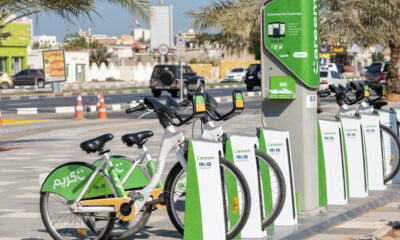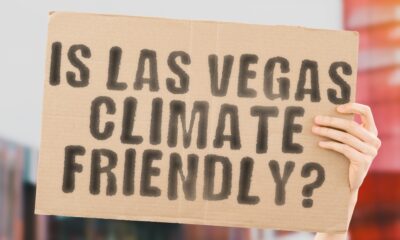

Features
Conservation conversation
Blue & Green Tomorrow spoke with Gavin Shelton, head of enterprise & innovation at Fauna & Flora International (FFI), about combining eco-tourism with genuine conservation in its upcoming gorilla trek to Africa.
This interview originally featured in B>’s Guide to Sustainable Tourism 2012.
What makes your trek to Uganda and Rwanda in 2013 so important?
If a picture tells a thousand words, then an experience like this could surely fill a novel! As a global conservation organisation, one of the key challenges we face is in meaningfully engaging the committed supporters of our work. We can tell them about the work we do; we can show them brochures of photos; and pinpoint locations on maps, but until they’ve been to visit our projects first hand, we can’t fully ignite the passion. By enabling some of our key supporters to get out into the field and directly experience our work, we can help them develop a deeper understanding of the region and the complex challenges that conservationists face in saving mountain gorillas. People who spend time in the company of gorillas are often quite deeply moved by the experience. We anticipate that participants will share their experiences and stories to leverage further support through wider social networks upon returning home.
How is the trip organised and what are participants likely to experience?
We have put together a bespoke ten-day itinerary that is focused on highlighting the work of the International Gorilla Conservation Programme (IGCP), which FFI co-founded in 1991 with the support of Sir David Attenborough. Participants will have several opportunities to spend time with gorillas in their natural habitat—getting ‘up close and personal’ with the great apes under the guidance and instruction of specially trained rangers and trackers.
Spending time with the world’s foremost gorilla experts—including Augustin Basabose, director of IGCP, who has worked with gorillas for over 20 years, and programme officer Stephen Asuma—is in itself a once in a lifetime opportunity. These are people who dedicate their lives to ensuring a sustainable future for gorillas. Our group will stay in high-end accommodation, designed and established by IGCP to enable local people to develop sustainable livelihoods that are not based on depletion of natural resources in gorilla habitats.
Although the focus is on gorillas and the work of the International Gorilla Conservation Programme, the group will also have opportunities to see other species such as golden monkeys, spend time exploring the artisan communities in and around the National Parks, and visit community enterprises founded by IGCP, which support communities and gorilla conservation.
Who are the lucky travellers?
There are only 12 places available on the trip and we expect places will go quickly. We had an excellent response amongst our supporter base when discussing the idea for a trip at a recent reception at the Athenaeum Club in London. The event was to provide an update on progress and say thank you to all those who have supported our work conserving the four gorilla subspecies across their ranges in Cameroon, Democratic Republic of Congo (DRC), Rwanda & Uganda; we were overwhelmed by the number of people keen to trek out to see gorillas in Africa. This trip is being implemented as a direct response to the enthusiasm shown by our supporters that night, and we will be marketing places initially to all of those who have supported our work in these regions.
However, we would be very happy to hear from anyone with whom we do not already have a relationship—anyone who would like to know more about the trip, make a provisional booking or register to receive details of other FFI journeys. We would urge them to do so promptly, though, as the limited places are expected to fill quickly once the final itinerary is published and bookings officially open.
Our Africa programme coordinator, Bruce Liggitt, will accompany the trip and share his knowledge, experience and passion for conserving gorillas and their habitat with the group throughout their time in Rwanda and Uganda. Also joining us will be multi-award winning conservation photographer, Robin Moore, who will be on hand to coach participants in getting the most out of their camera equipment to capture great images. Robin will also be putting together a book of images from the trip for all participants, which can be individually tailored.
What can individuals do to aid your cause?
Individuals can support our work in a number of different ways, for example, by joining FFI as a member—our packages start at just £36 per year. We also regularly launch public appeals for donations to support specific conservation projects that urgently require funds. This is how many of the supporters of our gorilla conservation work originally found out about us. We also have a charitable bond scheme—an innovative funding mechanism by which investors purchase bonds to support FFI and choose the return (up to a maximum of 10%) they would like to receive on their sustainable investment after five years when it is due for repayment. FFI benefits from as much as 15% of the total value of the investment.
For those who wish to support FFI in a very significant way, we also have two very active high-value donor programmes—Friends Against Extinction and The Conservation Circle—and an increasing number of our supporters are also choosing to support our work by pledging us a gift in their will. Many of our supporters also encourage their employers to consider whether a corporate partnership with FFI may be mutually beneficial for both the company and for conservation. Please contact the Development Office at FFI for details of any of these ways to help. We’d be delighted to hear from you on 01223 431 954.
What sets Fauna & Flora International apart?
As the world’s longest running conservation organisation (next year we celebrate out 110th birthday) FFI are known for concentrating on sustainable, lasting solutions to save wildlife and their habitat. All of our conservation is based on sound science, puts people at the heart of all solutions and tackles the wider causes of biodiversity loss.
FFI are different in that we possess impeccable scientific credentials, respond quickly to changes on the ground, and build up skills and capacity within each country to ensure the long-term sustainability of each of our projects. Constantly innovating, the sustainable conservation models developed by FFI are frequently replicated throughout the world.
We are also lean, with minimal overheads (95% of our income goes directly to delivery of conservation activities) and we enable our donor investments to work hard by leveraging further funds through collaboration.
From an eco-tourism point of view, why are gorilla treks so popular?
A large part of the popularity of gorilla trekking is down to the iconic nature of the species. They really are extraordinary animals and anyone who has gazed into the big brown eyes of a gorilla will never feel the same again about either their own origins or the desperate need to safeguard the gorilla’s future. This connection is not hard to fathom when you consider the fact that they share 98.3% of their DNA with us.
Another factor is that IGCP has been very proactive in building the capacity of the tourism sector to provide well-managed tourism activities that provide economic incentives for communities to protect gorillas rather than to hunt or trap them. Though, of course, preventing the latter is a constant battle.
It is probably worth noting here that there are a great many commercial trips advertised to see gorillas, many of which might bill their offerings as ‘eco-tourism’. The extent to which each trip is directly or indirectly benefiting gorillas, their habitat and the communities who share it with them differs wildly.
“A sustainable future for the planet, where biodiversity is effectively conserved by the people who live closest to it, supported by the global community” – What is needed to realise this vision?
Our vision is bold and aspirational, as a vision should be. However, the 2013 gorilla trip and others planned to the different countries in which we operate are all tangible examples of how we can work towards our vision. The 2013 gorilla trip uses accommodation set up and approved by IGCP to deliver maximum social and economic benefits to communities who previously relied on the unsustainable use of the natural resources around them. The income for gorilla conservation from gorilla trekking licenses and the employment associated with tourism brings additional economic benefits that make living gorillas much more valuable to local communities.
Bringing the people with the resources to make a significant difference to conservation into direct contact with these communities in the hope that they will in turn gain the support of their friends and peers is just one step we are taking towards enlisting the support of the wider global community.
 To fully realise our vision, we need a massive injection of resources—both financial and human—as the scale of the challenges facing future generations is considerable. However, we are optimists or we would not be engaged in this work. As Margaret Mead said, “Never doubt that a small group of thoughtful committed citizens can change the world; indeed, it’s the only thing that ever has.”
To fully realise our vision, we need a massive injection of resources—both financial and human—as the scale of the challenges facing future generations is considerable. However, we are optimists or we would not be engaged in this work. As Margaret Mead said, “Never doubt that a small group of thoughtful committed citizens can change the world; indeed, it’s the only thing that ever has.”
Further reading:
The Guide to Sustainable Tourism 2012


 Environment10 months ago
Environment10 months agoAre Polymer Banknotes: an Eco-Friendly Trend or a Groundswell?

 Environment11 months ago
Environment11 months agoEco-Friendly Home Improvements: Top 7 Upgrades for 2025

 Features9 months ago
Features9 months agoEco-Friendly Cryptocurrencies: Sustainable Investment Choices

 Features10 months ago
Features10 months agoEco-Friendly Crypto Traders Must Find the Right Exchange





























